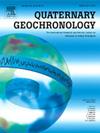A detailed quartz and feldspar luminescence chronology for the Khonako II loess section (Southern Tajikistan)
Abstract
Parts of Central Asia have been dominated by high dust flux since the start of the Quaternary. The resulting loess-palaeosol deposits are important archives for landscape and climate changes, but there is a lack of chronological data for the subaerial deposits of Southern Tajikistan. Our study presents a high-resolution luminescence chronology for the Khonako II section in the Khovaling region. Thirty-seven samples were collected from the first ∼8 m of the section, corresponding to the Holocene soil and the upper part of the Loess 1 (L1) unit. We applied quartz OSL dating to the coarse-silt fraction (40–63 μm) and polymineral pIRIR200,290 dating to the very fine sand fraction (63–90 μm). The polymineral pIRIR200,290 signal has satisfactory characteristics. The quartz dose response curve displays a non-single exponential growth above ∼100 Gy, thus, the De values were estimated by fitting a single exponential function plus linear component to the dose response data. To assess the pIRIR200,290 residual dose at deposition, we used the offset between our quartz and polymineral chronologies from Khonako II and equivalent doses measured on modern dust samples from Tajikistan and Uzbekistan. The resulting 9.2 ± 0.4 Gy dose was then subtracted from the pIRIR200,290 doses for final age calculation. The quartz OSL and pIRIR ages are then generally consistent. The obtained high-resolution luminescence chronology shows that the upper part of the L1 unit accumulated during the end of marine isotope stage (MIS) 3 and through MIS 2 (39–20 ka). The average dust accumulation rates (DAR) increased from ∼31 cm ka−1 to 41 cm ka−1 between MIS 3 and MIS 2. The DAR reached a peak of ∼71 cm ka−1 at 21 ka. A hiatus of ∼7–9 ka was then identified between the end of the last glacial maximum (LGM) and the beginning of the Holocene, and the average DAR decreased during the Holocene. Our results indicate a continuous high dust flux in the Khovaling plateau over the last 39 ka, but reworking processes and potential deflation events mark the LGM-Holocene transition. High-resolution luminescence dating studies in Tajikistan are therefore important to detect potential discontinuities in the sequences and provide an independent timescale for interpreting the climate proxies and calculating dust accumulation rates.

 求助内容:
求助内容: 应助结果提醒方式:
应助结果提醒方式:


